Maya News Updates 2009, No. 34: Kiuic, Yucatan - News from the Labna-Kiuic Regional Archaeological Project
Yesterday, Saturday September 19, 2009, the online version of the daily American newspaper USA Today posted a short update on the Labna-Kiuic Regional Archaeological Project (edited by MNU):
Yesterday, Saturday September 19, 2009, the online version of the daily American newspaper USA Today posted a short update on the Labna-Kiuic Regional Archaeological Project (edited by MNU):
Mysterious ruins may help explain Mayan collapse - Ringing two abandoned pyramids are nine palaces "frozen in time" that may help unravel the mystery of the ancient Maya, reports an archaeological team. Hidden in the hilly jungle, the ancient site of Kiuic was one of dozens of ancient Maya centers abandoned in the Puuc region of Mexico's Yucatan about 10 centuries ago. The latest discoveries from the site may capture the moment of departure.
"The people just walked away and left everything in place," says archaeologist George Bey of Millsaps College in Jackson Miss., co-director of the Labna-Kiuic Regional Archaeological Project. "Until now, we had little evidence from the actual moment of abandonment, it's a frozen moment in time."
The ancient, or "classic" Maya were part of a Central American civilization best known for stepped pyramids, beautiful carvings and murals and the widespread abandonment of cities around 900 A.D. in southern Mexico, Guatemala, Belize, and El Salvador. They headed for the northern Yucatan, where Spanish conquistadors met their descendants in the 1500s (6 million modern Maya still live in Central America today).
Past work by the team, led by Bey and Tomas Gallareta of Mexico's National Institute of Archaeology and History, shows the Maya had inhabited the Puuc region since 500 B.C. So why they headed for the coast with their brethren is just part of the mystery of the Maya collapse.
New clues may come from Kiuic, where the archaeologists explored two pyramids and, most intriguingly, plantation palaces on the ridges ringing the center. Of particular interst: a hilltop complex nicknamed "Stairway to Heaven" by Gallareta (that's "Escalera al Cielo" for Spanish-speaking Led Zeppelin fans) because of a long staircase leading from Kiuic to a central plaza nearly a mile away.
Both the pyramids and the palaces look like latter-day additions to Kiuic, built in the 9th century, just as Maya centers farther south were being abandoned. "The influx of wealth (at Kiuic) may spring from immigration," Bey says, as Maya headed north. One pyramid was built atop what was originally a palace, allowing the rulers of Kiuic to simultaneously celebrate their forebears and move to fancier digs in the hills.
When the team started exploring the hilltop palaces, five vaulted homes to the south of the hilltop plaza and four to the north, the archaeologists found tools, stone knives and axes, corn-grinder stones called metates and pots still sitting in place. "It was completely unexpected," Bey says. "It looks like they just turned the metates on their sides and left things waiting for them to come back."
"Their finds look very interesting and promising," says archaeologist Takeshi Inomata of the University of Arizona, who is not part of the project. "If it indeed represents rapid abandonment, it provides important implications about the social circumstance at that time and promises detailed data on the way people lived."
Inomata is part of a team exploring Aguateca, an abandoned Maya center in Guatemala renowned for its preservation. "I should add that the identification of rapid abandonment is not easy. There are other types of deposits — particularly ritual deposits — that result in very similar kinds of artifact assemblages," Inomata cautions, by email.
Bey and colleagues presented some of their findings earlier this year at the Society for American Archaeology meeting in Atlanta. The team hopes to publish its results and dig further at Kiuic to prove their finding of rapid abandonment there. "I think you could compare it to Pompeii, where people locked their doors and fled, taking some things but leaving others," Bey says.
So far, what drove people to leave the site remains a mystery, as it is for the rest of the ancient Maya. The only sign of warfare is a collection of spear points found in the central plaza of Kiuic. There are signs that construction halted there — a stucco-floored plaza sits half-complete, for example. "Drought seems more likely, that would halt construction," Bey says.
Having climbed the "Stairway to Heaven" a few times, Bey can answer one minor mystery, however. Why weren't the palace sites looted as so many other Maya sites have been? "The hills are a good climb," he says. "People just didn't bother to climb the hills to search the rooms." (written by Dan Vergano; source USA Today)
"The people just walked away and left everything in place," says archaeologist George Bey of Millsaps College in Jackson Miss., co-director of the Labna-Kiuic Regional Archaeological Project. "Until now, we had little evidence from the actual moment of abandonment, it's a frozen moment in time."
The ancient, or "classic" Maya were part of a Central American civilization best known for stepped pyramids, beautiful carvings and murals and the widespread abandonment of cities around 900 A.D. in southern Mexico, Guatemala, Belize, and El Salvador. They headed for the northern Yucatan, where Spanish conquistadors met their descendants in the 1500s (6 million modern Maya still live in Central America today).
Past work by the team, led by Bey and Tomas Gallareta of Mexico's National Institute of Archaeology and History, shows the Maya had inhabited the Puuc region since 500 B.C. So why they headed for the coast with their brethren is just part of the mystery of the Maya collapse.
New clues may come from Kiuic, where the archaeologists explored two pyramids and, most intriguingly, plantation palaces on the ridges ringing the center. Of particular interst: a hilltop complex nicknamed "Stairway to Heaven" by Gallareta (that's "Escalera al Cielo" for Spanish-speaking Led Zeppelin fans) because of a long staircase leading from Kiuic to a central plaza nearly a mile away.
Both the pyramids and the palaces look like latter-day additions to Kiuic, built in the 9th century, just as Maya centers farther south were being abandoned. "The influx of wealth (at Kiuic) may spring from immigration," Bey says, as Maya headed north. One pyramid was built atop what was originally a palace, allowing the rulers of Kiuic to simultaneously celebrate their forebears and move to fancier digs in the hills.
When the team started exploring the hilltop palaces, five vaulted homes to the south of the hilltop plaza and four to the north, the archaeologists found tools, stone knives and axes, corn-grinder stones called metates and pots still sitting in place. "It was completely unexpected," Bey says. "It looks like they just turned the metates on their sides and left things waiting for them to come back."
"Their finds look very interesting and promising," says archaeologist Takeshi Inomata of the University of Arizona, who is not part of the project. "If it indeed represents rapid abandonment, it provides important implications about the social circumstance at that time and promises detailed data on the way people lived."
Inomata is part of a team exploring Aguateca, an abandoned Maya center in Guatemala renowned for its preservation. "I should add that the identification of rapid abandonment is not easy. There are other types of deposits — particularly ritual deposits — that result in very similar kinds of artifact assemblages," Inomata cautions, by email.
Bey and colleagues presented some of their findings earlier this year at the Society for American Archaeology meeting in Atlanta. The team hopes to publish its results and dig further at Kiuic to prove their finding of rapid abandonment there. "I think you could compare it to Pompeii, where people locked their doors and fled, taking some things but leaving others," Bey says.
So far, what drove people to leave the site remains a mystery, as it is for the rest of the ancient Maya. The only sign of warfare is a collection of spear points found in the central plaza of Kiuic. There are signs that construction halted there — a stucco-floored plaza sits half-complete, for example. "Drought seems more likely, that would halt construction," Bey says.
Having climbed the "Stairway to Heaven" a few times, Bey can answer one minor mystery, however. Why weren't the palace sites looted as so many other Maya sites have been? "The hills are a good climb," he says. "People just didn't bother to climb the hills to search the rooms." (written by Dan Vergano; source USA Today)







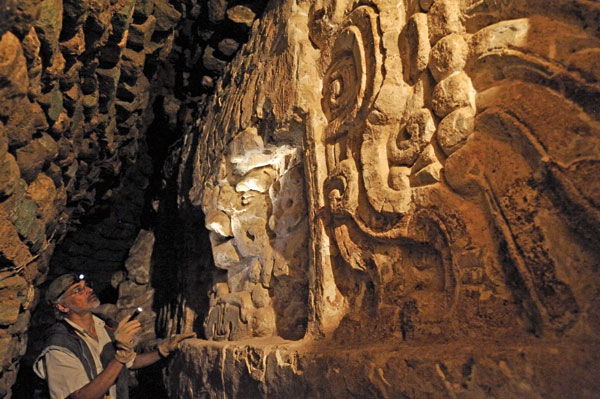
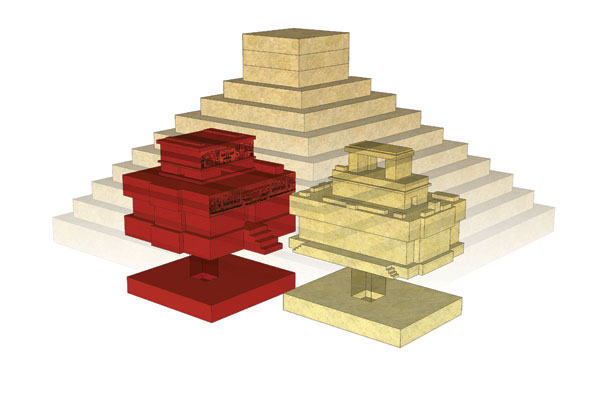
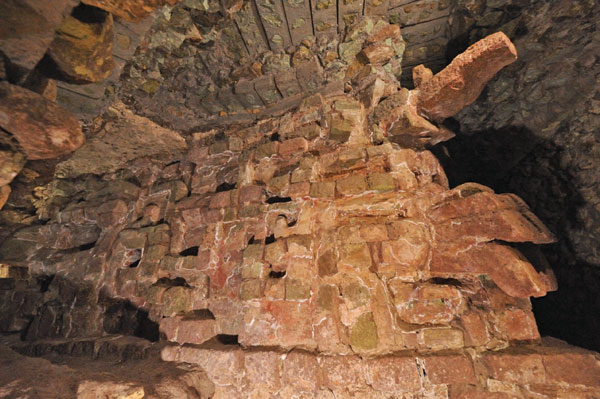





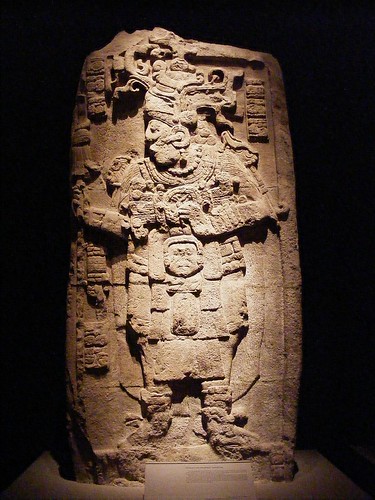


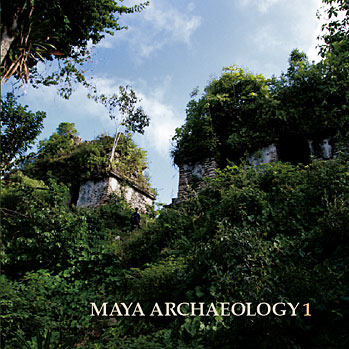









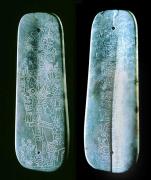


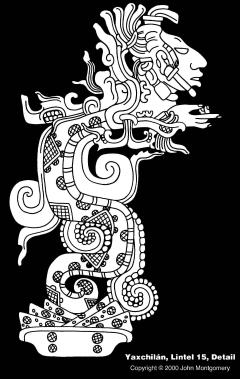




0 Comments:
Post a Comment
<< Home